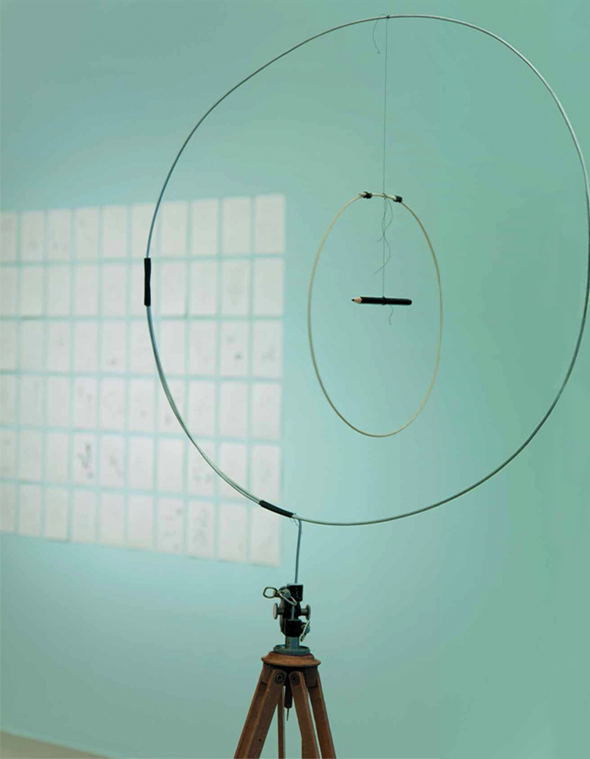Nikolaus Gansterer

1. What are you working on at the moment?
On many projects at once as usual: one is the Vienna Project, a giant map of sorts of the city, actually more like a multifaceted paper model – as well as an archive, or an atlas – based on letters and texts by Vienna residents at the end of the 30s in the wake of the Holocaust, which often describe a feeling of desperation and hopelessness throughout the city. From this I am developing a kind of parallel urban topography of memory. The paper model will then be digitized and made freely available as an app, with which to navigate the city while dealing with themes of memory and personal history. At the same time I’m preparing an installation for an exhibition in Detroit on the theme of drawing as thought and process, as well a new lecture-performance, which I am presenting in Sao Paulo this winter.
2. What does your schedule look like?
Get up, shower, brew some coffee, and off we go. During the day it’s mostly all management stuff: emails, phonecalls, shopping, etc. At night - if I still have the energy - the creative part of my work day begins. I don’t know what it’s like for other artists, but in my experience this is almost 70% management. Lists, loans, inquiries, transport.
3. Do you work in a studio? What does your work space look like?
I live in a very spacious old apartment, part of which I use as a studio for my paper works, drawings, models and so on, as well as an office. In the courtyard out the back is a workshop for the messy work – mind you, these days I’m approaching full capacity. In November I will start transferring a large part of the work into one of the beautiful two-story sculpture studios in the Prater. I'm really looking forward to that ... change of space = change of luck!
4. What do you get outsourced or find ready-made, and what do you make yourself?
My works vary a lot aesthetically depending on the specific project. I do all the drawings myself, and primarily the installations too. As works increase in scale and complexity I source assistants and helpers for the intense production phases and installation.
5. What does the internet mean to you in relation to your work / practice as an artist?
Oh, the Internet... I feel a great ambivalence. On one hand there’s so much time wasted on all this seemingly urgent information and inquiries - on the other hand you have instant networking opportunities and contact with loads of interesting people. And sure, Wikipedia has become indispensable for intital info-sourcing, but I find I still have to go to the library to do proper reseach.
6. What advice have you been given that you found really useful or helpful for you as an artist?
Mostly you have to experience it yourself, or you’ll want to anyway. But »keep at it«, »persevere« AND »stay happy« all the while are some pretty good guidelines.
7. What can you imagine yourself doing if you ever stopped making art?
To be honest, I can’t really imagine stopping at the moment. The idea of creating a garden sometime in the future is something I think sounds beautiful (and very romantic).
8. What are the pros and cons of working as an artist in Vienna?
I lived and worked in both Holland and Belgium for several years. Each place has its own specific dynamic. Rotterdam has excellent studio spaces for artists because of all the harbor buildings, and the scene is far less theory-oriented because of it. In Antwerp and Brussels, artists tend to move nimbly between object-making, text-based work and performance.
I find Vienna a very pleasant place, its manageable, distances to work and back are short (by bicycle!) and there is a high density of culture, including decent funding structures - compared to Berlin for example. But then there are not many alternative exhibition spaces and the rent on large factories (keyword: studio houses) is just too expensive, although there are so many just sitting around vacant. People in the dance, theater, performance, music and art scenes also tend to be very insular. Overall, due to its history of course, but also because of the prevailing immigration policy, Vienna is a very white city, more openness would definitely be beneficial.
9. What is the most absurd thing you’ve ever heard or read about your art?
?
10. Which show have you seen recently that you really liked and why?
A few days ago I was in Bratislava doing an artist’s talk, and I went to the Lubomir Ďurček exhibition in the Slovakian National Gallery. It was Situationist work, primarily in public space, from the seventies to today. Very fine. Ďurček come out of the same context as Július Koller, who I am more familiar with. Getting a sense of that milieu and the working conditions of this Czechoslovakian artist was really interesting.
29 October 2013. Translated from German by Signe Ross.
NIKOLAUS GANSTERER, born in 1974 in Klosterneuburg, Austria. Lives in Vienna and Berlin. Recent exhibitions include: My Brain is in my Inkstand, Cranbrook Museum, Detroit, USA; When Thought becomes Matter & Matter turns into Thought, Kunstraum Niederösterreich, Vienna; Thinking Matters, Galleria Marie-Laure Fleisch, Rome; Berlin Linienscharen, (Performance), Würtembergischer Kunstverein, Stuttgart (2013); Zeit(lose) Zeichen/Time(less) Signs, Künstlerhaus, Vienna; Diagrams/Schaubilder, Bielefelder Kunstverein, Bielefeld; A Study on Knowledge, Forum Stadtpark, Graz (2012).
DOWNLOAD PORTFOLIO
